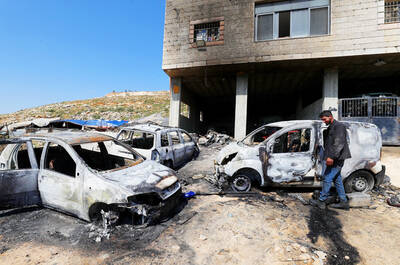Influenza has returned to Europe at a faster-than-expected rate this winter after almost disappearing last year, raising concerns about a prolonged “twindemic” with COVID-19 amid some doubts about the effectiveness of flu vaccines.
Lockdowns, mask-wearing and social distancing that have become the norm in Europe during the COVID-19 pandemic knocked out flu last winter, temporarily eradicating a virus that globally kills about 650,000 a year, EU data showed.
However, that has now changed as nations adopt less strict COVID-19 disease prevention measures due to widespread vaccination.
Since the middle of last month, flu viruses have been circulating in Europe at a higher-than-expected rate, the European Centre for Disease Prevention and Control (ECDC) reported this month.
The number of flu cases in European intensive care units (ICUs) last month rose steadily to peak at 43 in the final week of the year, ECDC and WHO data showed.
That is well below pre-pandemic levels — with weekly flu cases in ICUs peaking at more than 400 in the same period in 2018, but it is a big increase on last year, when there was only one flu case in an ICU in the whole of December, data showed.
The return of the virus could be the start of an unusually long flu season that could stretch well into the summer, said Pasi Penttinen, the ECDC’s top expert on influenza.
“If we start to lift all measures, the big concern I have for influenza is that, because we have had such a long time of almost no circulation in the European population, maybe we will shift away from normal seasonal patterns,” Penttinen said.
He said dismantling restrictive measures in the spring could prolong the circulation of flu far beyond the normal end of the European season in May.
A “twindemic” could put excessive pressure on already overstretched health systems, the ECDC said in its report.
In France, three regions — including Paris — are facing a flu epidemic, French Ministry of Social Affairs and Health data showed.
This season, France has so far recorded 72 serious cases of flu, with six deaths.
Further complicating matters, the dominant flu strain circulating this year appears so far to be H3 of the A virus, which usually causes the most severe cases among the elderly.
Penttinen said it was too early to make a final assessment of flu vaccines because a larger number of ill patients was needed for real-world analysis, but laboratory tests showed that the vaccines available this year “are not going to be optimal” against H3.
That is largely because there was very little or no virus circulating when the vaccines’ composition was decided last year, making it harder for vaccine makers to predict which strain would be dominant in the flu season.
Vaccines Europe, which represents top vaccine makers in the region, acknowledged the strain selection was made more difficult by very low flu circulation last year, but added that there was not enough data yet to assess the effectiveness of this season’s shots.
Flu vaccines are adapted every year to make them as effective as possible against ever-changing flu viruses.
Their composition is decided six months before the flu season begins, based on circulation of viruses in the opposite hemisphere. That gives time for drugmakers to develop and make the shots.
European data on flu vaccine uptake is not yet available, but national figures for France show that coverage is not as broad as authorities hoped for.
The authorities there extended by one month the vaccination period to the end of next month to boost inoculations. Figures released last week showed that 12 million people have so far been vaccinated, about 45 percent of the target population.
“There is still a large room for improvement to limit the impact of the flu epidemic,” the French health ministry said in a statement on Tuesday last week.
This year’s target is to vaccinate 75 percent of people at risk.
Vaccines Europe said the industry had supplied large numbers of flu shots, despite the strain on production facilities posed by the COVID-19 pandemic.

Republican US lawmakers on Friday criticized US President Joe Biden’s administration after sanctioned Chinese telecoms equipment giant Huawei unveiled a laptop this week powered by an Intel artificial intelligence (AI) chip. The US placed Huawei on a trade restriction list in 2019 for contravening Iran sanctions, part of a broader effort to hobble Beijing’s technological advances. Placement on the list means the company’s suppliers have to seek a special, difficult-to-obtain license before shipping to it. One such license, issued by then-US president Donald Trump’s administration, has allowed Intel to ship central processors to Huawei for use in laptops since 2020. China hardliners

A top Vietnamese property tycoon was on Thursday sentenced to death in one of the biggest corruption cases in history, with an estimated US$27 billion in damages. A panel of three hand-picked jurors and two judges rejected all defense arguments by Truong My Lan, chair of major developer Van Thinh Phat, who was found guilty of swindling cash from Saigon Commercial Bank (SCB) over a decade. “The defendant’s actions ... eroded people’s trust in the leadership of the [Communist] Party and state,” read the verdict at the trial in Ho Chi Minh City. After the five-week trial, 85 others were also sentenced on

Conjoined twins Lori and George Schappell, who pursued separate careers, interests and relationships during lives that defied medical expectations, died this month in Pennsylvania, funeral home officials said. They were 62. The twins, listed by Guinness World Records as the oldest living conjoined twins, died on April 7 at the Hospital of the University of Pennsylvania, obituaries posted by Leibensperger Funeral Homes of Hamburg said. The cause of death was not detailed. “When we were born, the doctors didn’t think we’d make 30, but we proved them wrong,” Lori said in an interview when they turned 50, the Philadelphia Inquirer reported. The

RAMPAGE: A Palestinian man was left dead after dozens of Israeli settlers searching for a missing 14-year-old boy stormed a village in the Israeli-occupied West Bank US President Joe Biden on Friday said he expected Iran to attack Israel “sooner, rather than later” and warned Tehran not to proceed. Asked by reporters about his message to Iran, Biden simply said: “Don’t,” underscoring Washington’s commitment to defend Israel. “We are devoted to the defense of Israel. We will support Israel. We will help defend Israel and Iran will not succeed,” he said. Biden said he would not divulge secure information, but said his expectation was that an attack could come “sooner, rather than later.” Israel braced on Friday for an attack by Iran or its proxies as warnings grew of